trunk MITSUBISHI MIRAGE G4 2020 Owner's Manual (in English)
[x] Cancel search | Manufacturer: MITSUBISHI, Model Year: 2020, Model line: MIRAGE G4, Model: MITSUBISHI MIRAGE G4 2020Pages: 253, PDF Size: 36.39 MB
Page 6 of 253
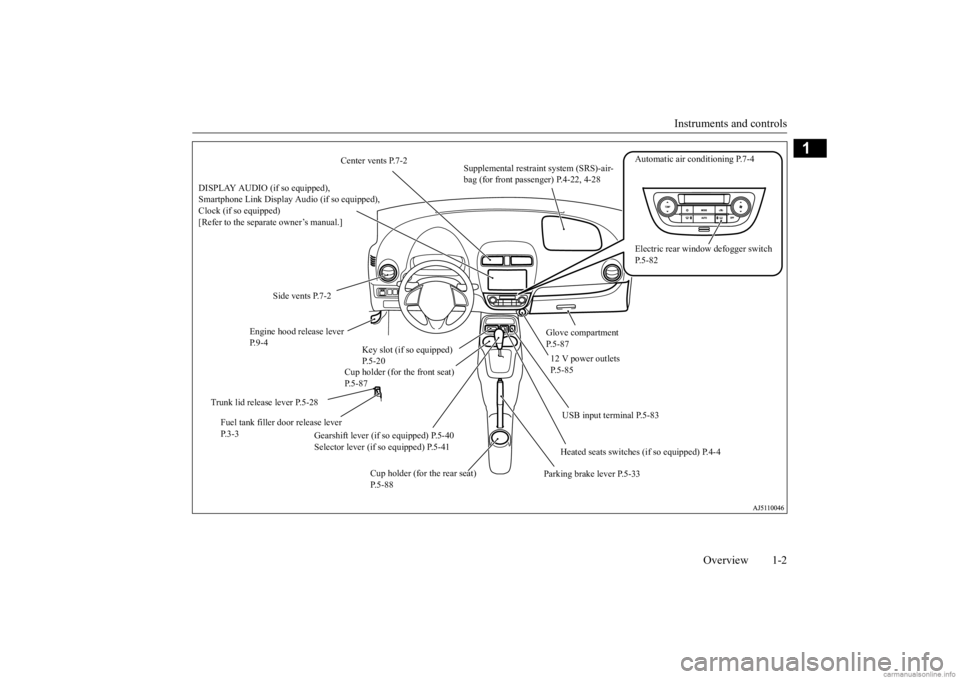
Instruments and controls
Overview 1-2
1
Center vents P.7-2
Supplemental restraint system (SRS)-air- bag (for front passenger) P.4-22, 4-28
Automatic air conditioning P.7-4
Side vents P.7-2
Glove compartment P.5-87
Engine hood release lever P. 9 - 4
Cup holder (for the front seat) P.5-87
12 V power outlets P.5-85
Electric rear window defogger switch P.5-82
Key slot (if so equipped) P.5-20
Gearshift lever (if so equipped) P.5-40 Selector lever (if so equipped) P.5-41
Fuel tank filler door release lever P. 3 - 3
Parking brake lever P.5-33
Cup holder (for the rear seat) P.5-88
DISPLAY AUDIO (if so equipped), Smartphone Link Display Audio (if so equipped), Clock (if so equipped)[Refer to the separate owner’s manual.]
USB input terminal P.5-83 Heated seats switches (if so equipped) P.4-4
Trunk lid release lever P.5-28
BK0284300US.book 2 ページ 2019年5月23日 木曜日 午後12時22分
Page 7 of 253

Interior 1-3 Overview
1
N00100302620
Interior
Bottle holders P.5-88
Power window lock switch P.5-30
Sun visors P.5-84 Vanity mirror P.5-84 Ticket holder P.5-84
Power door lock switch P.5-27
Dome light P.5-86, 9-30
Inside rearview mirror P.5-34
Head restraints P.4-5
Power window switch P.5-30
Seat belts P.4-7
Supplemental restraint system (SRS)- curtain airbags P.4-22, 4-33
Tether anchorages for child restraint system P.4-17
Front seats P.4-2
Supplemental restraint system (SRS)-side airbags (for front seat) P.4-22, 4-32
Arm rest P.4-5
Jack P.8-5
Rear seat P.4-5
Cup holder (for the rear seat) P.5-88
Assist grips P.5-89
Arm rest (Driver’s seat only, if so equipped) P. 4-4
Microphone [Refer to the separate owner’s manual.]
Trunk-through lid P.4-5
Convenience hook P.5-88
BK0284300US.book 3 ページ 2019年5月23日 木曜日 午後12時22分
Page 8 of 253
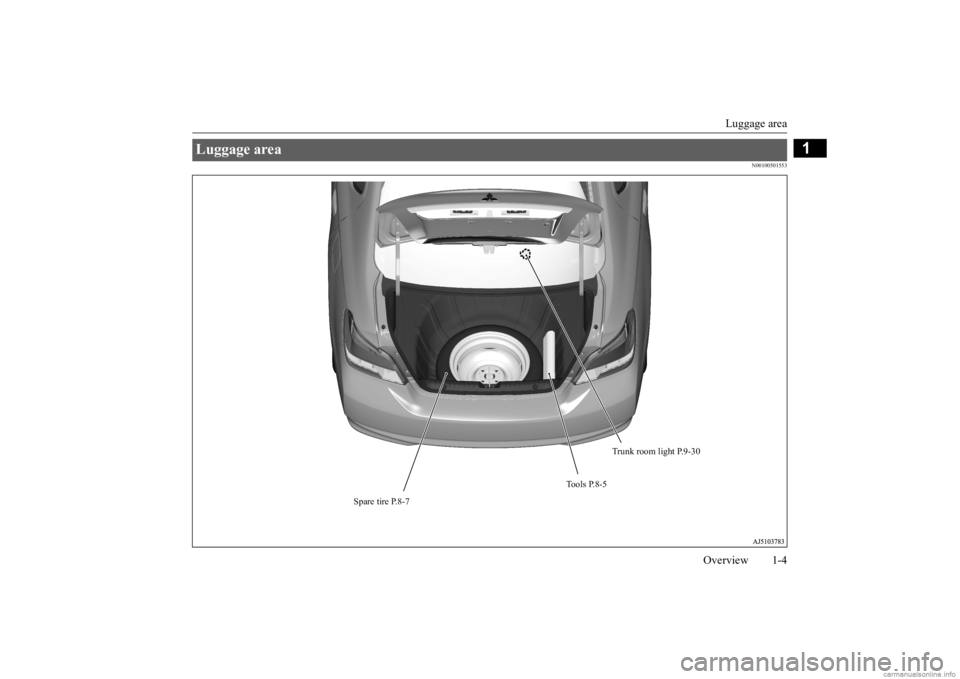
Luggage area
Overview 1-4
1
N00100501553
Luggage area
To o l s P. 8 - 5
Spare tire P.8-7
Trunk room light P.9-30
BK0284300US.book 4 ページ 2019年5月23日 木曜日 午後12時22分
Page 10 of 253
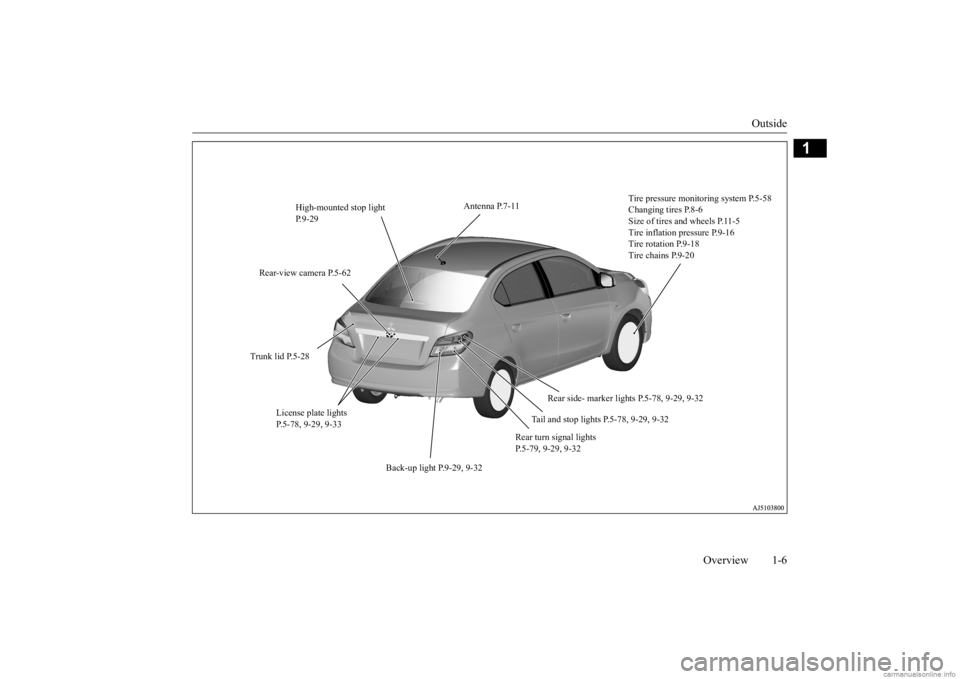
Outside
Overview 1-6
1
High-mounted stop light P.9-29
Tire pressure monitoring system P.5-58 Changing tires P.8-6 Size of tires and wheels P.11-5Tire inflation pressure P.9-16 Tire rotation P.9-18 Tire chains P.9-20
Trunk lid P.5-28
Tail and stop lights P.5-78, 9-29, 9-32
Rear-view camera P.5-62
Rear turn signal lights P.5-79, 9-29, 9-32
License plate lights P.5-78, 9-29, 9-33
Back-up light P.9-29, 9-32
Antenna P.7-11
Rear side- marker lights P.5-78, 9-29, 9-32
BK0284300US.book 6 ページ 2019年5月23日 木曜日 午後12時22分
Page 29 of 253
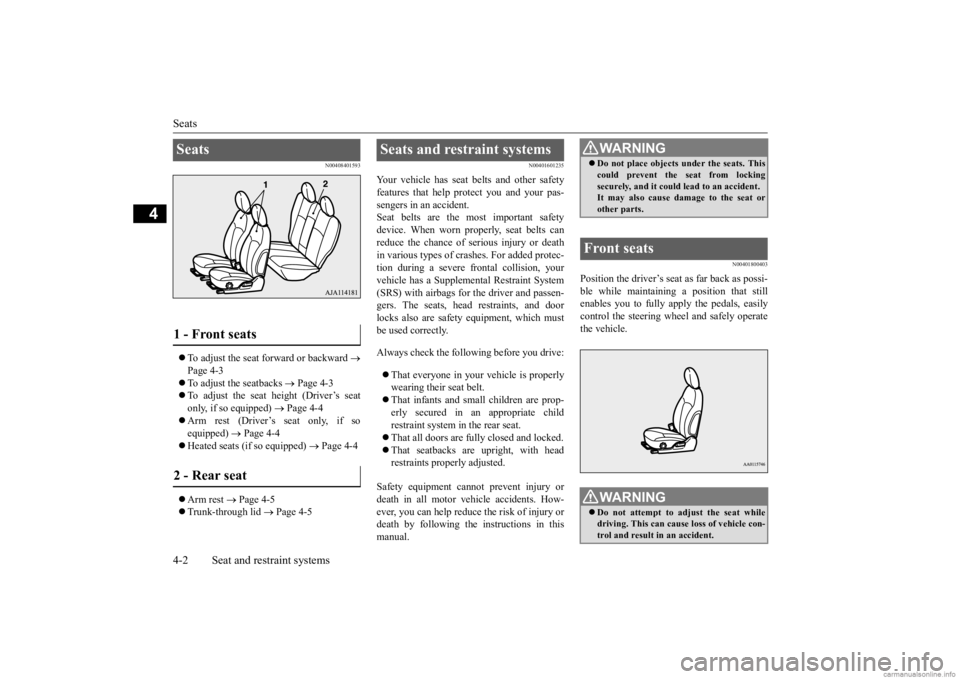
Seats 4-2 Seat and restraint systems
4
N00408401593
To adjust the seat forward or backward
Page 4-3 To adjust the seatbacks
Page 4-3
To adjust the seat height (Driver’s seat only, if so equipped)
Page 4-4
Arm rest (Driver’s seat only, if so equipped)
Page 4-4
Heated seats (if so equipped)
Page 4-4
Arm rest
Page 4-5
Trunk-through lid
Page 4-5
N00401601235
Your vehicle has seat
belts and other safety
features that help
protect you and your pas-
sengers in an accident.Seat belts are the most important safety device. When worn properly, seat belts can reduce the chance of serious injury or deathin various types of cras
hes. For added protec-
tion during a severe fr
ontal collision, your
vehicle has a Supplemen
tal Restraint System
(SRS) with airbags for the driver and passen- gers. The seats, head restraints, and doorlocks also are safety equipment, which must be used correctly. Always check the follow
ing before you drive:
That everyone in your vehicle is properly wearing their seat belt. That infants and small children are prop- erly secured in an appropriate child restraint system in
the rear seat.
That all doors are fully closed and locked. That seatbacks are upright, with head restraints properly adjusted.
Safety equipment cannot prevent injury or death in all motor ve
hicle accidents. How-
ever, you can help reduce the risk of injury or death by following the
instructions in this
manual.
N00401800403
Position the driver’s seat as far back as possi-ble while maintaining a position that stillenables you to fully a
pply the pedals, easily
control the steering wheel and safely operate the vehicle.
Seats 1 - Front seats 2 - Rear seat
Seats and restraint systems
WA R N I N G Do not place objects under the seats. This could prevent the seat from lockingsecurely, and it could lead to an accident.It may also cause damage to the seat or other parts.
Front seats
WA R N I N G Do not attempt to adjust the seat while driving. This can cause loss of vehicle con- trol and result
in an ac
cident.
BK0284300US.book 2 ページ 2019年5月23日 木曜日 午後12時22分
Page 32 of 253
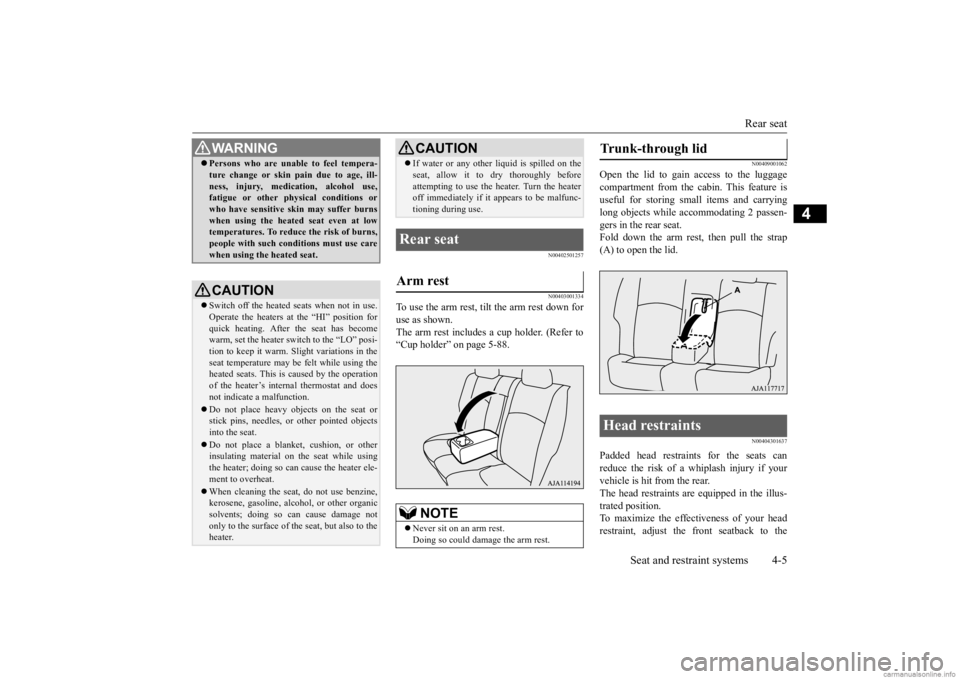
Rear seat
Seat and restraint systems 4-5
4
N00402501257 N00403001334
To use the arm rest, tilt the arm rest down for use as shown. The arm rest includes a cup holder. (Refer to“Cup holder” on page 5-88.
N00409001062
Open the lid to gain access to the luggage compartment from the cabin. This feature is useful for storing small items and carryinglong objects while ac
commodating 2 passen-
gers in the rear seat. Fold down the arm rest, then pull the strap(A) to open the lid.
N00404301637
Padded head restraints for the seats can reduce the risk of a whiplash injury if your vehicle is hit from the rear.The head restraints are equipped in the illus- trated position. To maximize the effectiveness of your headrestraint, adjust the front seatback to the
WA R N I N G Persons who are unable to feel tempera- ture change or skin
pain due to age, ill-
ness, injury, medication, alcohol use,fatigue or other phys
ical conditions or
who have sensitive sk
in may suffer burns
when using the heated seat even at lowtemperatures. To reduce the risk of burns, people with such conditions must use care when using the heated seat.CAUTION Switch off the heated seats when not in use. Operate the heaters at the “HI” position for quick heating. After the seat has become warm, set the heater switch to the “LO” posi-tion to keep it warm. Sl
ight variations in the
seat temperature may be felt while using the heated seats. This is caused by the operationof the heater’s internal thermostat and does not indicate
a malfunction.
Do not place heavy objects on the seat or stick pins, needles, or
other pointed objects
into the seat. Do not place a blanket,
cushion, or other
insulating material on the seat while usingthe heater; doing so can
cause the heater ele-
ment to overheat. When cleaning the seat, do not use benzine, kerosene, gasoli
ne, alcohol, or other organic
solvents; doing so can cause damage not only to the surface of the seat, but also to theheater.
If water or any other li
quid is spilled on the
seat, allow it to dry thoroughly beforeattempting to use the heater. Turn the heateroff immediately if it
appears to be malfunc-
tioning during use.
Rear seat Arm rest
NOTE
Never sit on an arm rest. Doing so could damage the arm rest.CAUTION
Trunk-through lid Head restraints
BK0284300US.book 5 ページ 2019年5月23日 木曜日 午後12時22分
Page 49 of 253
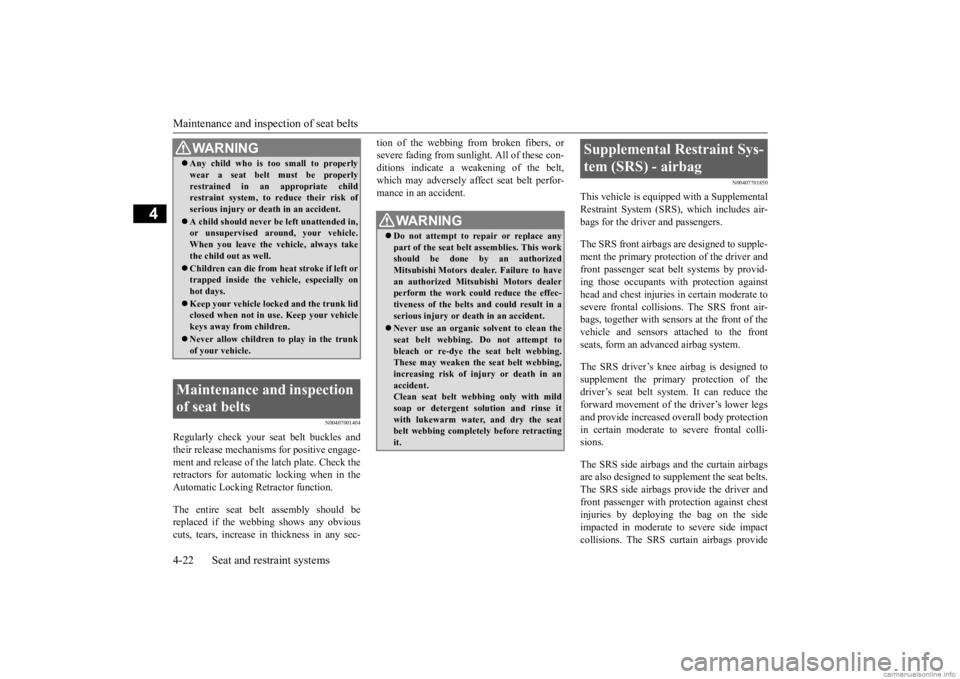
Maintenance and inspection of seat belts 4-22 Seat and restraint systems
4
N00407001404
Regularly check your seat belt buckles and their release mechanisms for positive engage- ment and release of the latch plate. Check theretractors for automatic locking when in the Automatic Locking Retractor function. The entire seat belt assembly should be replaced if the webbing shows any obviouscuts, tears, increase in thickness in any sec-
tion of the webbing from broken fibers, or severe fading from sunlig
ht. All of these con-
ditions indicate a weakening of the belt, which may adversely affe
ct seat belt perfor-
mance in an accident.
N00407701850
This vehicle is equippe
d with a Supplemental
Restraint System (SRS), which includes air- bags for the driver and passengers. The SRS front airbags are designed to supple- ment the primary protection of the driver and front passenger seat belt systems by provid- ing those occupants w
ith protection against
head and chest injuries
in certain moderate to
severe frontal collisi
ons. The SRS front air-
bags, together with sensors at the front of the vehicle and sensors attached to the front seats, form an adva
nced airbag system.
The SRS driver’s knee airbag is designed to supplement the primary protection of the driver’s seat belt system. It can reduce the forward movement of the driver’s lower legsand provide increased
overall body protection
in certain moderate to
severe frontal colli-
sions. The SRS side airbags and the curtain airbags are also designed to s
upplement the seat belts.
The SRS side airbags provide the driver and front passenger with pr
otection against chest
injuries by deploying the bag on the side impacted in moderate
to severe side impact
collisions. The SRS curtain airbags provide
WA R N I N G Any child who is too small to properly wear a seat belt
must be properly
restrained in an appropriate childrestraint system, to reduce their risk of serious injury or de
ath in an
accident.
A child should never be
left unattended in,
or unsupervised around, your vehicle. When you leave the ve
hicle, always take
the child out as well. Children can die from heat stroke if left or trapped inside the vehicle, especially on hot days. Keep your vehicle locked and the trunk lid closed when not in use. Keep your vehicle keys away from children. Never allow children to
play in the trunk
of your vehicle.
Maintenance and inspection of seat belts
WA R N I N G Do not attempt to repair or replace any part of the seat belt assemblies. This work should be done by an authorized Mitsubishi Motors dealer. Failure to havean authorized Mitsub
ishi Motors dealer
perform the work could reduce the effec- tiveness of the belts an
d could result in a
serious injury or de
ath in an accident.
Never use an organic solvent to clean the seat belt webbing. Do not attempt to bleach or re-dye th
e seat belt webbing.
These may weaken the
seat belt webbing,
increasing risk of in
jury or death in an
accident. Clean seat belt webb
ing only with mild
soap or detergent solution and rinse it with lukewarm water, and dry the seat belt webbing completely before retractingit.
Supplemental Restraint Sys- tem (SRS) - airbag
BK0284300US.book 22 ページ 2019年5月23日 木曜日 午後12時22分
Page 66 of 253
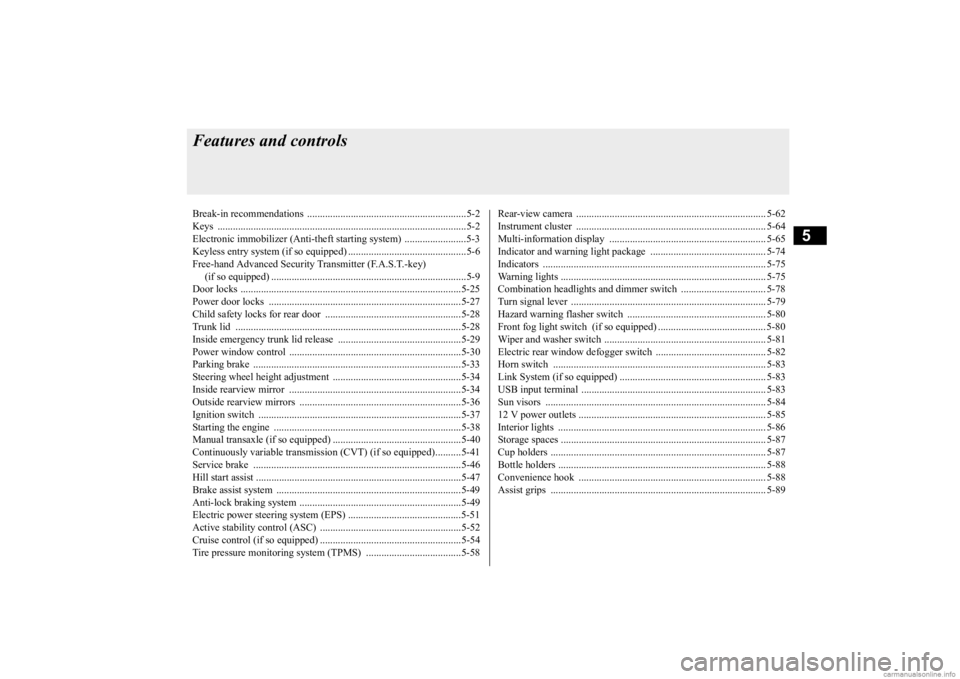
5
Features and controlsBreak-in recommendations ..............................................................5-2 Keys .................................................................................................5-2 Electronic immobilizer (Anti-theft starting system) ........................5-3Keyless entry system (if so equipped) ..............................................5-6 Free-hand Advanced Security
Transmitter (F.A.S.T.-key)
(if so equipped) ............................................................................5-9Door locks ......................................................................................5-25 Power door locks ......
...........
...........
...........
...........
...........
.........
.....5-27
Child safety locks for rear door ..........
...........
.........
.........
.........
.....5-28
Trunk lid ................
............
...........
...........
...........
...........
...........
.....5-28
Inside emergency trunk lid release ................................................5-29 Power window control ...................................................................5-30Parking brake .................................................................................5-33 Steering wheel height adjustment ..................................................5-34 Inside rearview mirror ...................................................................5-34Outside rearview mirrors ...............................................................5-36 Ignition switch ...............................................................................5-37 Starting the engine .........................................................................5-38Manual transaxle (if so equipped) ..................................................5-40 Continuously variable transmission
(CVT) (if so equipped)..........5-41
Service brake .................................................................................5-46Hill start assist ................................................................................5-47 Brake assist system ........................................................................5-49 Anti-lock braking system ...............................................................5-49Electric power steering system (EPS) ............................................5-51 Active stability control (ASC) .......................................................5-52 Cruise control (if so equipped) .......................................................5-54Tire pressure monitoring system (TPMS) .....................................5-58
Rear-view camera .......................................................................... 5-62 Instrument cluster .......................................................................... 5-64 Multi-information display ............................................................. 5-65Indicator and warning light package ............................................. 5-74 Indicators ....................................................................................... 5-75 Warning lights ................................................................................ 5-75Combination headlights and dimmer switch ................................. 5-78 Turn signal lever ............................................................................ 5-79 Hazard warning flasher switch ...................................................... 5-80Front fog light switch (if so equipped) .......................................... 5-80 Wiper and washer switch ............................................................... 5-81 Electric rear window defogger switch ....
...........
...........
...........
...... 5-82
Horn switch ................................................................................... 5-83 Link System (if so equipped) ......................................................... 5-83 USB input terminal ....
...........
...........
...........
...........
...........
............. 5-83
Sun visors ...................................................................................... 5-84 12 V power outlets ......................................................................... 5-85 Interior lights ................................................................................. 5-86Storage spaces ................................................................................ 5-87 Cup holders .................................................................................... 5-87 Bottle holders ................................................................................. 5-88Convenience hook ............
...........
...........
...........
...........
...........
...... 5-88
Assist grips .................................................................................... 5-89
BK0284300US.book 1 ページ 2019年5月23日 木曜日 午後12時22分
Page 74 of 253
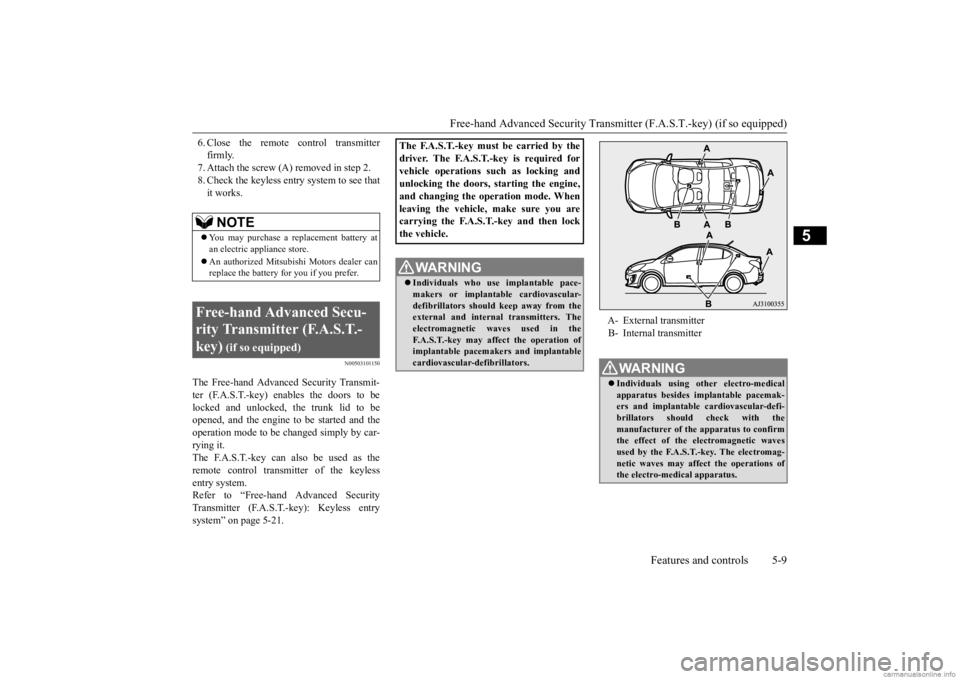
Free-hand Advanced Securi
ty Transmitter (F.A.S.T.-key) (if so equipped)
Features and controls 5-9
5
6. Close the remote control transmitter firmly.7. Attach the screw (A) removed in step 2. 8. Check the keyless entry system to see that it works.
N00503101150
The Free-hand Advanced Security Transmit- ter (F.A.S.T.-key) enables the doors to be locked and unlocked, the trunk lid to beopened, and the engine to be started and the operation mode to be changed simply by car- rying it.The F.A.S.T.-key can also be used as the remote control transmitter of the keyless entry system.Refer to “Free-hand
Advanced Security
Transmitter (F.A.S.T.-key): Keyless entry system” on page 5-21.
NOTE
You may purchase a replacement battery at an electric appliance store. An authorized Mitsubish
i Motors dealer can
replace the battery for you if you prefer.
Free-hand Advanced Secu- rity Transmitter (F.A.S.T.-key)
(if so equipped)
The F.A.S.T.-key must be carried by the driver. The F.A.S.T.-key is required for vehicle operations su
ch as locking and
unlocking the doors,
starting the engine,
and changing the operation mode. When leaving the vehicle,
make sure you are
carrying the F.A.S.T.-key and then lockthe vehicle.
WA R N I N G Individuals who use
implantable pace-
makers or implanta
ble cardiovascular-
defibrillators should keep away from the external and internal
transmitters. The
electromagnetic w
aves used in the
F.A.S.T.-key may affe
ct the operation of
implantable pacemakers and implantablecardiovascular-defibrillators.
A- External transmitter B- Internal transmitterWA R N I N G Individuals using ot
her electro-medical
apparatus besides implantable pacemak- ers and implantable
cardiovascular-defi-
brillators should
check with the
manufacturer of the apparatus to confirm the effect of the el
ectromagnetic waves
used by the F.A.S.T.-key. The electromag-netic waves may affect
the operations of
the electro-medical apparatus.
BK0284300US.book 9 ページ 2019年5月23日 木曜日 午後12時22分
Page 75 of 253

Free-hand Advanced
Security Transmitter (F.A.S
.T.-key) (if so equipped)
5-10 Features and controls
5
The operations possible with the F.A.S.T.- key can be modified as stated below.(Keyless entry operations are possible.) For details, contact an authorized Mitsubishi Motors dealer.• Enabling only the locking and unlocking of the doors and the opening of the trunk lid• Enabling only the starting of the engine • Deactivating the F.A.S.T.-key
N00503201265
When a person enters the operating range of the F.A.S.T.-key while carrying the F.A.S.T.- key and presses the driver’s door lock/unlock switch the trunk lid ope
n switch, verification
of the ID code is performed. The doors can only be locked and unlocked, the trunk lid can only be opened, the enginecan only be started and the operation mode can only be changed when the ID codes of the vehicle and F.A.S.T.-key match.
The operating range is
within about 2.3 feet
(70 cm) of the driver’s door lock/unlockswitch and the trunk lid open switch.
NOTE
The F.A.S.T.-key uses weak electromagnetic waves. In cases such as the following, operationmay be improper or unstable. • The vehicle is near a facility that emits strong electromagnetic
waves, such as a TV
transmitting tower, a pow
er station, a radio
station or an airport • The key is carried together with other com- munication devices such
as cellular phones
or radios, or electrical appliances such as computers • The F.A.S.T.-key touches or is covered by a metal object • A keyless entry system is being used nearby • The battery of the F.A.S.T.-key is run down • The vehicle is in
a location with strong
electromagnetic
waves or noise
Use the emergency key in such circum- stances.Refer to “To operate without using theF.A.S.T.-key” on page 5-19. The F.A.S.T.-key is constantly performing reception operations
in its communication
with the vehicle. This means that the battery is always running down, regardless of howoften the F.A.S.T.-key is used. The battery life is about 1 to 2 years, depending on the usage conditions. Since the F.A.S.T.-key is constantly perform- ing reception operati
ons, the reception of
strong electromagnetic
waves can accelerate
the running down of the ba
ttery. Do not place
near to electrical appliances such as televi-sions or computers.
Operating range of the F. A . S . T. - k e y
NOTE
NOTE
When the battery of the F.A.S.T.-key has run down or there are st
rong electromagnetic
waves or noise in the area, the operating range could decrease
or operations could
become unstable.
Operating range for locking and unlocking the doors and opening the trunk lid
BK0284300US.book 10 ページ 2019年5月23日 木曜日 午後12時22分